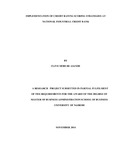| dc.description.abstract | Credit reference reports help banks stem out misconduct in the banking sector since
customers whose credit reports indicate as having been involved in malpractices are
subjected to stringent terms and conditions. Credit information sharing to bank
customers, is expected to minimize the problem of information asymmetry in the
financial sector. Information asymmetry between banks and borrowers is one of the main
contributors to high cost of credit as banks tend to load a risk premium to borrowers
because of lack of customer information. This in turn, increases cost of borrowing,
meaning high repayment instalments of loans which translate to a high level of default.
The Credit Information Sharing (CIS) apparatus is therefore expected to facilitate the
development of information capital to reduce information asymmetry or increase
information symmetry and allow cost of credit to decline substantially. It is therefore
expected that savings arising from the sharing of credit information will translate to lower
cost of credit. The executive management at National Industrial Credit Bank which
comprises of 7 executives was interviewed directly using an already set interview guide
as so to access their opinion on what they perceived to be the successes in
implementation of credit rating scoring strategies and the measures they have taken to
mitigate the challenges. The study used primary data that was collected using interview
guide containing both structured and unstructured questions. Given this fact, content
analysis was used to analyze the data. Findings from the study indicated that there were
various challenges affecting NIC bank in its implementation of credit score rating
process. These included structure, culture, technology, leadership, lack of focus, choice
of external service strategy consultants, competition in the industry, very high cost of
operation, and substitute products/services. The study concludes that the organization
had in a way been able to amend its implementation of credit score rating process as per
the challenges. This was through application of all management functions namely
planning, controlling, organizing, motivating, leading, directing, integrating,
communicating, and innovation to the implementation process. From the findings, the
study also concluded that over 90% of the challenges faced by NIC bank while
implementing their strategy are largely attributable to the internal environment. These
challenges revolve around the organizational resources and organizational processes. This
clearly shows that managers place little or no emphasis on implementation phase while
they are drafting their strategies. Most of these challenges are avoidable if they have been
accounted for during the analysis and formulation stages. It is obvious that many
strategies fail to realize the anticipated benefits due to challenges encountered during
implementation. The study recommends that for a successful strategy implementation,
firms in Kenya should adopt such measures as; spending more time on analysis so as to
identify problems that could surface in implementation phase. | en_US |

